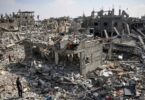Jonathan Hall / Abeer Ahmad / Sofia Nordenving / Gustaf Gredebäck
Millions of children’s development at stake: What can be done?
Approximately 452 million children were living in a conflict zone in 2020, and almost half of the roughly 80 million forcibly displaced people worldwide are children. Many of the countries most affected by conflict are developing countries with a young and growing population.
War and displacement entail a wide range of adversity, with several negative impacts on children’s psychological development. These include mental health disorders, emotional and conduct problems, and impaired cognitive development, which have relevance for their life opportunities, including social relations, school performance and labour market success. While physical development is important, the development of the child’s emotional, social and cognitive abilities is equally crucial. The early years of childhood represent the ‘window of opportunity’ that shapes the child’s whole development experience throughout life. Research shows that the development potential of 250 million children under five years (around 43 per cent) in low- and middle-income countries is at stake. Also, there is a high probability that children will experience delayed early childhood development with exposure to local conflicts, and this delay increases with chronic exposure.
Perhaps somewhat surprising, however, is that research has also uncovered widespread resilience and even increased prosocial behaviour among children exposed to war violence. Resilience is a broad concept concerning the capacity to respond when challenged, return to stability, adjust to a new normal, or transform to survive or flourish. One approach to building resilience is the protection of child mental health and development through providing special care in the early stages of a child’s life. Addressing children’s resilience and early childhood psychological development is essential to limit human suffering, rebuild war-torn societies and evade recurring conflicts. Therefore, an important question is: What could be done to protect child development in the midst of conflict?
This SIPRI Topical Backgrounder provides an overview of existing aid-supported programmes and current practices to protect and promote children’s psychological development in war and displacement, followed by a review of a selection of rigorous research from the body of relevant literature to suggest ways forward.
Current practice of child programmes in conflict
The study reviewed the current practice and programmes, adopted by international organizations alone or in collaboration with local partners, to address children’s psychological development in conflict. The review identified that most programmes target children’s development (including wellbeing and mental health) only in a broad sense. Very few programmes, however, specifically address children’s cognitive development, and fewer still focus on children under five years old. Most of the existing interventions that target child populations in war and conflict focus on societal processes and war prevention such as recruitment prevention, demobilization, reintegration of child soldiers and general educational activities. Regarding children’s psychological development, there is an increased focus on mental health and psychosocial support (MHPSS). The current interventions can be divided into two main strategies: The first consists of specialized and focused support aiming at directly impacting the child, while the second focuses on building support around the child by improving the capacity and skills of parents and communities. The programmes mainly target children and youth between the ages of 10 and 16. Community-based MHPSS for children along with their parents and caregivers in humanitarian situations has grown exponentially in recent years. In 2020 UNICEF reached around 47.2 million beneficiaries in 139 countries, compared with around 3–4 million in previous years.
Mental health and psychosocial interventions targeting children directly
Programmes targeting children directly are mainly small in scale, are provided by specialist practitioners to groups or through individual tailor-made therapy sessions, and target child mental health through clinical approaches such as cognitive behavioural therapy (CBT). These programmes typically include a mix of activities directed at the child and are sometimes accompanied by other components directed at family members. One example is the classroom-based intervention Psychosocial Care for Children in Conflict Areas (PCCCA), designed by the HealthNet Transcultural Psychosocial Organisation (TPO). The programme aims to reduce distress and enhance resilience among children in conflict settings, and it has targeted over 96 000 children in Burundi, Indonesia, Nepal, Sri Lanka and Sudan. The five-week group intervention includes various concepts from creative, expressive and experiential therapy, cooperative play, parental support and CBT. Another example of a small-scale programme is the Early Adolescent Skills for Emotions (EASE) programme developed by the World Health Organization. The programme aims to improve the mental health of young adolescents (aged between 10 and 14 years) living in adversity, through group-based sessions that can be delivered by non-specialist providers. The sessions aim to improve caregivers’ skills to support children and young adolescents. To date, EASE has been piloted in Jordan, Lebanon, Pakistan and Tanzania. However, the effort was launched in 2019, and results remain to be assessed.
Mental health and psychosocial interventions focusing on community and family support
Programmes focused on community and family support are typically delivered as educational sessions or workshops. They have the benefit of being implemented on a larger scale, guided by handbooks for conducting the activities. One of the most widely used scalable interventions for psychosocial support and child protection in emergencies is Child-friendly Spaces (CFS). The main goal of the programme is to provide children on the move with a safe environment in which they can play, learn and express themselves freely. The programme was launched in 1999 and is still ongoing in many countries and several refugee and internally displaced persons camps. The programme targets two age groups (5 to 9 years and 10 to 12 years) and their caregivers and parents, in parallel with community members. The activities involve drawing, making collages, dancing, and playing sports or other games. Another large-scale programme is the Children’s Resilience Programme initiated by Save the Children and the Psychosocial Centre of the International Federation of Red Cross and Red Crescent Societies (IFRC) in 2010. The programme consists of multiple workshops of planned activities, including four meetings with parents and caregivers that focus on children’s positive coping mechanisms and resilience.
To summarize, while important gains can been made by focusing on adolescents, the review identifies missed opportunities during the crucial window of opportunity to strengthen child development before the age of five.
State of the art and identifying the research–practice gap
Research may strengthen child programmes by evaluating their efficacy and offering a deeper understanding of the mechanisms of change involved. This section draws from a selection of rigorous research related to the main strategies presented to identify how research and practice can together advance the protection of child development in conflict (see figure 1). The literature explains the negative impacts of trauma on children’s cognitive, emotional and behavioural processes by their intensity, severity, chronicity and developmental timing. In addition, a child’s response to trauma is dependent on individual differences and the surrounding environment. Younger children are more dependent than older children on the quality of their relationships with caregivers.
Summary of study findings
Figure 1. A summary of findings from reviewing the current practice (programmes) and state of the art (scientific literature)
The conditions of war and displacement demand interventions that are cost-efficient, sustainable and target those that need them the most. Also, interventions should build on available resources to avoid creating external dependency and undermining existing long-term capacity. However, the challenges involved in conducting rigorous research in conflict settings have created a research–practice gap: The majority of research evaluates the effects of focused interventions, while in practice the majority of interventions are non-focused and geared towards broader goals such as strengthening community support or offering safe spaces.
Focused and non-focused interventions directed at the child
When experiencing war, personal pre-conditions may determine the recovery trajectory. For instance, higher self-esteem is associated with less deterioration in children’s mental health. As described, specialized services and focused interventions are predominantly directed at processes within the child, enhancing their capacity to cope by improving internal capacities. Cognitive behavioural strategies, psychoeducation, or creative expressive activities are commonly used towards this. Of these, some evidence from case studies suggests that psychoeducation or restructuring of unhelpful cognitions are beneficial for treating traumatic stress, and positive results are found for active problem solving as a treatment mechanism. However, in general, the evidence is mixed: Some meta-analyses find broad benefits for post-traumatic stress disorder (PTSD) symptoms and coping factors, while other meta-analyses show lack of evidence for their efficacy. A randomized controlled trial of the PCCCA revealed short-term improvements in social–behavioural outcomes and resilience, especially among girls, and reduced psychological difficulties and aggression among boys compared with a control group, while psychiatric symptoms remained the same.
The impact of focused interventions also varies by age, displacement status and family size. Their efficiency is further moderated by personal characteristics. More alarmingly, some interventions have negative impacts on mental health and coping strategies. In a study with war-affected youth in Uganda, gender and abduction history moderated the effectiveness of group depression therapy, with a slightly negative outcome on male non-abducted subjects. Also, results from a school-based mental health intervention in Sri Lanka found that girls who had not yet received the treatment experienced more reduction in PTSD symptoms than those in the treatment group. Further, in a study of a mediation programme focusing on both the social relationships and mental health of children in Palestine, PTSD symptoms increased in the experimental group compared with the control group. The mental health of girls exposed to high levels of military violence did, however, benefit from improved friendships, exemplifying the complex interaction between child mental health and a number of contextual factors.
Community and school interventions
Despite being the most commonly implemented intervention in practice, there is a lack of rigorous research on the effects of boosting community and family support through interventions. War disrupts communities through separation, loss of lives and dissolved trust. One approach to protect children is to strengthen the critical social bonds around them. Consolidation of group identity increases resilience in war. Social capital—the degree to which children believe their community is trustworthy and cohesive—is associated with a lower prevalence of mental illness and more social support, and, accordingly, migration may challenge their sense of belonging and identity. Refugee youth with high-quality friendships and wide social support networks are less prone to PTSD symptoms and show more prosocial behaviour such as caring, helping and sharing.
Most psychosocial interventions are school based, which may be because schools offer access to children, and this kind of intervention is perceived as more socially acceptable compared with individual interventions. A positive school climate can be a protective factor as a safe haven. However, the evidence for school-based interventions is mixed, with relatively small effects on mainly behaviour or social support. Their impact varies depending on family relationships, which may predict the effectiveness of the interventions. While there are positive effects for children with poor family relationships, indications show that children with positive family relationships can improve their mental health without an intervention. Child-focused interventions—whether school or group based—might strengthen relationships, but they do not address ongoing stress originating from families or communities. It is also less clear how they affect the child’s cognitive development.
Caregiver and family interventions
The resilience of children is significantly impacted by daily stressors in their environment that are heightened during war. A positive parenting style and warmth moderate the relationship between war exposure, mental health and academic achievement. Meanwhile, maltreatment is an underlying factor of the negative impact on children’s mental health and cognitive functions. Predictable relationships with caregivers may support healthy development of emotional regulation, laying a foundation for well-functioning future interactions.
Parenting interventions that are focused on increasing parental warmth and support while reducing hostility are particularly useful for war-affected families. Responsive caregiving was found to have a positive effect in a meta-analysis of parenting interventions across 33 countries for children during their first three years of life. Interventions also had a more significant effect on early childhood development and parenting practices in low- and middle-income countries than in high-income countries. Despite the apparent association between parents’ resilience and their parenting capacity, it is only recently that attention has been given to the process linking the resilience of parents to that of their children. However, many of the interventions included in the analysis did not measure any parenting outcomes, and very few had an explicit component to address parental mental health. A pilot study of a caregiver support intervention (CSI) indicates that adding mental health components to parenting interventions may increase parental warmth and child psychosocial wellbeing.
Parental distress contributes to mental distress in children. Findings indicate that the experience of trauma by children has no significant effect on their recovery trajectory. However, trauma experienced by the family has substantial impacts on the development of children. Research on exposure to traumatic war events during pregnancy shows that mothers’ mental health shapes the quality of interactions with their infants, which is associated with the child’s development. Mothers’ stress levels negatively impact the social cognitive development of their children, as evident by findings among Syrian refugee families. The attachment relationship between refugee mothers and their children is likely to be impaired by psychological distress, increasing the risk of maltreatment, which reinforces insecure attachment and undermines child mental health. While no equivalent pattern is found between fathers and children, there are direct effects between fathers’ and children’s mental health. Evidence suggests that fathers are critically important for early childhood development, although only a few interventions engage fathers. In general, the relationship between fathers’ mental health and their children is less studied.
Closing the research–practice gap
This review of current child programming practices and academic research shows a gap between research and practice. Further, the existing research is often of poor quality and lacking standardized outcome measures that are culturally and linguistically appropriate. As a result, there are increasing calls to address the inconsistencies and heterogeneity of outcomes affecting the advancement of child intervention research in war and displacement. The following issues need to be addressed to help to begin closing the gap. First, practitioners and researchers need to work together to identify how different intervention components impact different age groups. For instance, current programming usually targets children above five years old, with a focus on children between 10 and 16 years, and not children under five as recommended in research. Focusing on children under five with the aim of enhancing children’s holistic development within the ‘window of opportunity’ is necessary. Second, there is a need to increase understanding of the interaction between intervention mechanisms and contextual factors, such as differences in personal resources, development phases and the environment around the child. Third, understanding when it would be more efficient to target parents or caregivers rather than relying on the child’s abilities as an indicator could result in more sustainable outcomes. Lastly, interventions that promote resilience through targeting children’s cognitive development—and thereby provide children with tools to navigate their way to personal independence and success in their adult lives—are largely absent from both research and practice.
Lessons learned: What could be done to protect child development in the midst of conflict?
The review in this backgrounder suggests that much can be improved when it comes to efficiently allocating external aid to where it is needed most, in particular, among children under five years. Resources might best be allocated to environmental interventions unless they are tailored to the child’s specific needs. Also, the efficacy of school programmes is influenced by the child’s home environment and personal characteristics. This raises the question of whether strategies should selectively target children predisposed to risk factors rather than being universally implemented in schools. In addition, the role of caregivers and their mental health in child development during times of war is crucial. Considering the lack of interventions targeting young children, an increased effort to promote positive parenting and mental health among parents of children in this age range seems strongly justified. For long-term development, addressing parental mental health could improve existing large-scale development programmes. Therefore, a scalable, cost-efficient approach addressing parental mental health potentially offers the largest benefits, especially when directed at parents of children under the age of five years.
About the authors
Jonathan Hall (United States/Sweden) was a Senior Researcher on Peacebuilding with the SIPRI Peace and Development research area.
Abeer Ahmad (Egypt) is a Research Assistant with the SIPRI Peace and Development research area.
Sofia Nordenving (Sweden) is a Research Assistant with the Department of Peace and Conflict Research, Uppsala University.
Gustaf Gredebäck (Sweden) is a Professor of Developmental Psychology and Head of the Uppsala Child and Baby Lab, Uppsala University.






